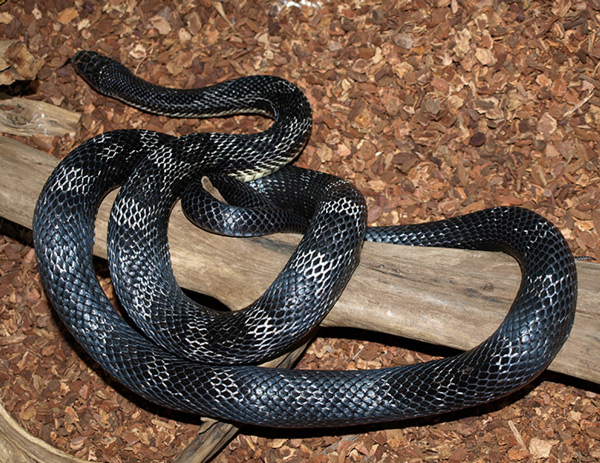Eastern Rat Snake
Pantherophis obsoletus
Description
Juvenile rat snakes are gray with brown blotches and look very much like fox snakes. As they age, they become darker in color. Adults are black with white lips, chin, and throat.
Size
This type of snake can grow up to six feet in length and weighs between 1.1-4.9 pounds (0.5-2.2 kg).
Adaptations
- The non-venomous eastern rat snake is a constrictor, meaning that it kills its prey by suffocation.
- When alarmed, the eastern rat snake will vibrate its tail rapidly in leaves to simulate the sound of a venomous rattlesnake.
- If it is picked up, this snake can produce a foul-smelling musk to release upon the attacker.
Diet
In the wild, the eastern rat snake’s diet consists of small vertebrates including rodents, frogs, lizards, squirrels, juvenile rabbits and opossums, birds, and bird eggs. Cosley Zoo’s eastern rat snake is fed mice once a week.
Reproduction
Eastern rat snakes mate as early as the end of April, and the breeding season continues into late May or early June. In late June or July, the female buries 12 to 20 eggs under a rotten log, decaying leaf litter, or a rock. The leathery-shelled eggs are white, oblong and about 1.4-2.4 inches (3.5-6.1 centimeters) long. The eggs hatch in approximately 9 to 10 weeks. The young snakes require no parental care.
Shelter and Space Needs
The eastern rat snake is a terrestrial snake species that can be found in many different habitats, including hardwood forests and woodlands, wooded canyons, swamps, rocky timbered uplands, wooded areas of streams and rivers, farmland near woods, old fields, barnyards, and rural buildings in wooded areas. This species is often found in environments where wooded and open habitats are intermixed. It often climbs trees, especially rough-barked species or those with vines. It may occasionally be seen in the water. Eastern rat snakes hibernate in deep crevices or underground.
Life Expectancy
Eastern rat snakes can live up to 20 years.
Relationship With Man
Eastern rat snakes benefit people by controlling populations of mice and rats. Rat snakes are also popular as pets due to their calm demeanor.
Fun Facts
- The entire body of a snake is covered with scales – even its eyes! Because of this, snakes have no eyelids and cannot blink or close their eyes.
- Why is that snake sticking out its tongue? To smell! The forked ends of the tongue fit into two holes in the snake’s mouth which are part of Jacobson’s organ. This organ transmits information about the smell to the brain.
- Although many people think that snakes are slimy, their scales really just feel dry. Snakes have diamond-shaped scales on the top of their body, and long skinny scales called scutes on their undersides.







